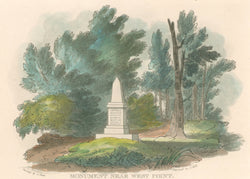Joshua Shaw (ca. 1777-1860). “Monument Near West Point.” [North Point, Dundalk, Baltimore County]. From Picturesque Views of American Scenery.
Philadelphia: M. Carey & Son, 1819-21. Vignette, ca. 6 1/2 x 8; paper 12 x 15. Aquatint with line etching by John Hill. Original hand color. Very good condition. First State. Deák: 315; Fowble: 275.
This small monument was erected in 1817 by the comrades of Aquila Randall who at age 24 was killed defending Baltimore at the battle of North Point on September 12, 1814. It still stands on North Point Road in Dundalk near Old Battle Grove Road. The title of this print was corrected in a later edition to North Point.
This print is from a very rare group of prints from a foundation work in the history of American views, the first systematic attempt to record the country’s landscape. The series combines the work of some of the most talented Americans in the early nineteenth century, including the artist Joshua Shaw. Shaw was born and trained in England, where he became a landscape artist, exhibiting at the Royal Academy. With a recommendation of his work from Benjamin West, Shaw emigrated to Philadelphia in 1817. He was enthralled by his new country, and as a result conceived the grand scheme of producing a folio of prints based on “correct delineations of some of the most prominent beauties of notable scenery.” He planned to travel throughout the United States to make his drawings, and to issue the prints by subscription in six sets of six views each.
The aquatinting of the prints was done by John Hill (1770-1850), who was another Englishman who had just settled in Philadelphia. This was Hill’s first major American commission, and the next year he moved to New York City where he further enhanced his reputation as the premier aquatinter in the country. The publisher of the series, Mathew Carey & Son, was no less illustrious than the others. Mathew Carey was perhaps the dominate American publisher of the first two decades of the nineteenth century, and the successor firms of Carey & Son, and then Carey & Lea continued to play an important part in the history of American maps, books and prints.
This series is seminal in the history of American prints, the first time anyone tried to produce an overall artistic documentation of American scenery. The scenes are mostly of the eastern seaboard, ranging from New York to Georgia. They show America when the country was primarily rural, and they tend to focus on the inland waterways, which were the major routes of travel and major sources of energy at the time. These prints provide us with a precious snapshot of our land in its nascent age, when it would still have been recognizable to the colonists of the previous century. The prints are quite lovely, beautifully rendered and exquisitely aquatinted. Unfortunately, the project was not a financial success and only eighteen of the intended thirty-six prints were produced. A second edition of the portfolio was issued by Thomas T. Ash in 1835, the prints from that issue as rare as the first edition by Carey & Son. These rare prints provide us with an unusual and unique look at America in its adolescence.
Other scenes by this artist:
View Near The Falls of Schuylkill
Falls of St. Anthony on the Mississippi
View on the North River [Hudson]

![Shaw, Joshua “Monument Near West Point.” [North Point, Dundalk, Baltimore County]](http://philaprintshop.com/cdn/shop/products/shawhillmonumentc_{width}x.jpg?v=1675190562)
![Shaw, Joshua “Monument Near West Point.” [North Point, Dundalk, Baltimore County]](http://philaprintshop.com/cdn/shop/products/shawhillmonument_{width}x.jpg?v=1675190567)
![Load image into Gallery viewer, Shaw, Joshua “Monument Near West Point.” [North Point, Dundalk, Baltimore County]](http://philaprintshop.com/cdn/shop/products/shawhillmonumentc_110x110@2x.jpg?v=1675190562)
![Load image into Gallery viewer, Shaw, Joshua “Monument Near West Point.” [North Point, Dundalk, Baltimore County]](http://philaprintshop.com/cdn/shop/products/shawhillmonument_110x110@2x.jpg?v=1675190567)
